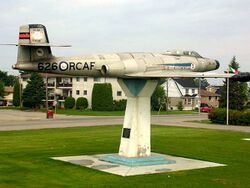Engineering:Cruciform tail
From HandWiki
Short description: Aircraft tail configuration
The cruciform tail is an aircraft empennage configuration which, when viewed from the aircraft's front or rear, looks much like a cross. The usual arrangement is to have the horizontal stabilizer intersect the vertical tail somewhere near the middle, and above the top of the fuselage. The design is often used to locate the horizontal stabilizer away from jet exhaust, propeller and wing wake, as well as to provide undisturbed airflow to the rudder.[1][2][3]
Prominent examples of aircraft with cruciform tails include the Avro Canada CF-100 Canuck, the British Aerospace Jetstream 31, the Fairchild Swearingen Metroliner, and the Rockwell B-1 Lancer.
See also
References
- ↑ "Which Aircraft Designs Feature Cruciform Tails?". 16 July 2022. https://simpleflying.com/which-aircraft-designs-feature-cruciform-tails/.
- ↑ "Cruciform tail Pros and Cons". thoracentesis.science. https://www.thoracentesis.science/2022/03/cruciform.html.
- ↑ "Aircraft Horizontal and Vertical Tail Design". 8 August 2017. https://aerotoolbox.com/design-aircraft-tail/.
 |



